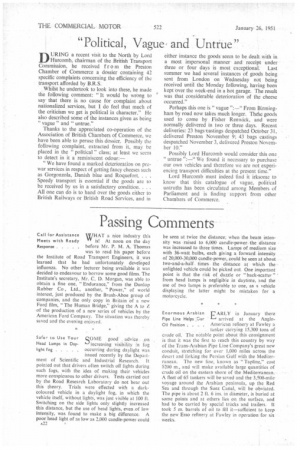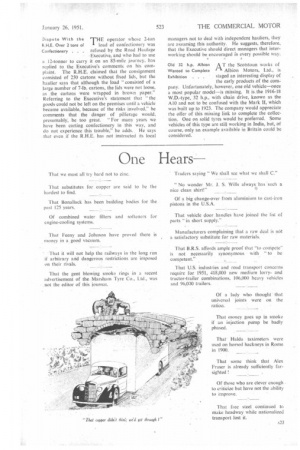Passing Comments
Page 24

Page 25

If you've noticed an error in this article please click here to report it so we can fix it.
Cali for Assistance WHAT a nice industry this Meets with Ready rv is! At noon on the day Response before Mr. P. M. A. Thomas was to read his paper before the Institute of Road Transport Engineers, it was learned that he had unfortunately developed influenza. No other lecturer being available it was decided to endeavour to borrow some good films. The Institute's secretary, Mr. C. D. Morgan, was able to obtain a fine one, "Endurance," from the Dunlop Rubber Co, Ltd., another, "Power," of world interest, just produced by the Brush-Aboe group of companies, and the only copy in Britain Of a new Ford film, "The Human Bridge," giving the A to 1 of the production of a new series of vehicles by the American Ford Company, The situation was thereby saved and the evening enjoyed.
Safer to Use Your SOME good . advice on Head Lamps in Day"increasing visibility in fog light Fog occurring during daylight was issued recently by the Depai Iment of Scientific and Industrial Research. It pointed out that drivers often switch off lights during such fogs, with the idea of making their vehicles more conspicuous to other drivers. Tests carried out by the Road Research Laboratory do not bear out this theory. Trials were effected with a darkcoloured vehicle in a daylight fog, in which the vehicle itself, without lights, was just visible at 100 ft. Switching on the side lights only slightly increased this distance, but the use of head lights, even.of low intensity, was found to make a big difference. A poor head light of as low as 2,000 candle-power could
a22
be seen at twice the distance; when the beam intensity was raised to 6,000 candle-power the distance was increased to three times. Lamps of medium size with 36-watt bulbs, each giving a forward intensity of 20,000-30,000 candle-power, could be seen at about two-and-a-half times the distance at which the unlighted vehicle could be picked out. One important point is that the risk of dazzle or "back-scatter" • from head lamps is negligible in daytime, and the use of two lamps is preferable to one, as a vehicle displaying the latter might be mistaken for a motorcycle.
Enormous Arabian ARLY in January there Pipe Line Helps .',Dur arrived at the Anglo Oil Position , . , American refinery at Fawley a
tanker carrying 15,300 tons of crude oil. The notable point about this consignment is that it was the first to reach this country by way of the Trans-Arabian Pipe Line Company's great new conduit, stretching for over 1,000 miles across the desert and linking the Persian Gulf with the Mediterranean. The new line, known as " Tapline," cost $200 m., and will make available large quantities of crude oil on the eastein shore of the Mediterranean. A fleet of 65 tankers will be saved and the 3,500-mlie voyage around the Arabian peninsula, up the Red Sea and through the Suez Canal, will be obviated. The pipe is about 2 ft. 6 ins. in diameter, is buried at some points and at others lies on the surface, and had to be carried by special tricks and trailers. It took 5 m. barrels of oil to fill it—sufficient to keep the new Esso refinery at Fawley in operation for six weeks.
,Dispute With the THE operator whose 2-ton
R.H.E. Over 2 tons or I load of confectionery was Confectionery refused by the Road Haulage -Executive, and who had to use
12-tonner to carry it on an 85-mile journey, has replied to the Executive's comments on his complaint. The R.H.E. claimed that the consignment consisted of 250 cartons without fixed lids, but the haulier says that although the load "consisted of a large number of 7-lb. cartons, the lids were not loose, as the cartons were wrapped in brown paper." Referring to the Executive's statement that "the goods could not be left on the premises until a vehicle became available, because of the risks involved," he comments that the danger of pilferage would, presumably, be too great. "For many years we have been carting confectionery in this way, and do not experience this trouble," he adds. He says that even if the R.H.E. has not instructed its local
managers not to deal with independent hauliers, they are assuming this authority. He suggests, therefore, that the Executive should direct managers that interworking should be encouraged ih every possible way.
Old 32 hp. Albion A T the Scotstoun works of Wanted to Complete " Albion Motors, Ltd., is Exhibition . . . staged an interesting display of
the early products of the company. Unfortunately, however, one old vehicle—once a most popular model—is missing. It is, the 1916-18 W.D,-type, 32 h.p., with chain drive, known as the A10 and not to be confused with the Mark II, which was built up to 1923. The company would appreciate the offer of this missing link to complete the collection. One on solid tyres would be preferred. Some vehicles of this type are still working in India, but, of course, only an example available in Britain could be considered.




















































































